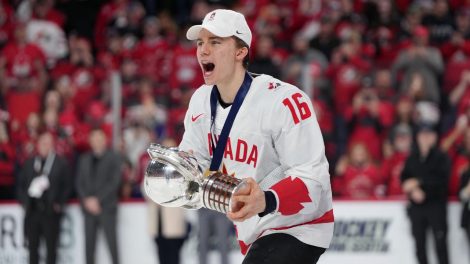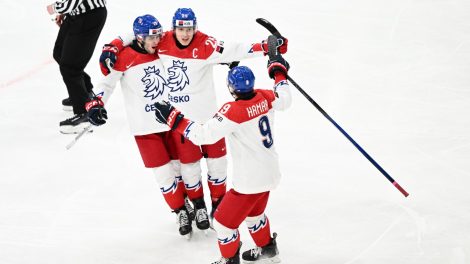With preliminary play now complete at the world juniors, here’s a few takeaways.
Canada’s more traditional look
Since Mike Babcock coached Canada to gold at the 2014 Sochi Olympics, Canada has leaned heavily on mostly skilled lineups, allowing the talent to work itself out in terms of lineup composition. Previous to that time, Canada would typically have a structure of a top scoring line, a secondary scoring line, an energy line, and a physical line. There was clear definition between top and bottom six.
Canada’s lineup looks a lot more like a top-6, bottom-6 than it does the all-skilled groups we’ve been accustomed to in recent years. There may be two factors that have impacted this structure. First, the players available. With two NHL forwards and high-end stars like Connor Bedard and Brennan Othmann, there’s plenty to round out two skilled lines or a 1A and a 1B.
Parity Party
With 19 returning players from the summer, Czechia proved that experience is everything, securing top spot in Pool A. With a new mindset, Slovakia is no longer an easy out. The Slovaks now play to win, instead of playing to avoid losing. Switzerland’s three wins in preliminary play — all in overtime or shootout — is a sign of prominence in the program. Even Latvia, who won just once, looked competitive. Each team in Pool B won at least one game. Only the Austrians went winless, and they were situated in Pool A. As usual, the Finns and Swedes were up to the task, advancing to play each other in the quarters. If and when Russia returns, the parity in this tournament will be even better. In my opinion, this is the most parity I’ve seen in recent memory.
Fantilli’s impact
Adam Fantilli has yet to light it up but as my colleague Jason Bukala writes, there may still be time. I wonder how much a player coming from the NCAA has to assimilate to a group composed primarily of CHL players?
Curls
Bedard’s ability to continuously use his curl and drag move is stunning, it’s like Alex Ovechkin setting up on the one-time side on the PP. You know it’s coming, but you can’t stop it.
Austrian Pride
Tough go for Austria, but they did score twice and made things interesting in a relegation-deciding game on Friday. With the net empty, and Austria’s best players out there for extended shifts, both Vinzenz Rohrer and David Reinbacher made desperation plays to stop two German empty-net attempts, despite the game being virtually over. This tournament matters a lot to those countries not always privileged to earn a spot in the top grouping.
Another Anaheim D prospect
Canada’s most underrated player is Sherbrooke’s Tyson Hinds. He brings a lot of different elements to the game, and his details are subtle but solid. The Anaheim pick’s +9 rating was the best amongst all Canadian defenceman in the first four games.
Lest we forget
As I was reminded on my trip through Detroit for the Red Wings’ 4-2 win over Ottawa, patience is required with prospects. Detroit has a number of players they’re looking to build their future around with Jonatan Berggren, Simon Edvinsson, and Sebastian Cossa to name a few. The same must be said about draft-eligible players in this event. By no means what you’ve witnessed is representative of the finished product.
The world juniors has a lasting affect on players who have participated. In a conversation with Moritz Seider, he explained how he and former German teammate now Ottawa Senator Tim Stützle had dinner together the night before their game in Detroit on Saturday, and had a keen eye on the Austria-Germany game. The Germans’ 4-2 victory meant they’re able to maintain their position in the top group for the 2024 tournament. Clearly a sense of national pride.
On another note, Joe Veleno of the Red Wings, who represented Canada twice (winning gold in 2020), said he felt the overall the competition was better this year, despite Canada’s two blowout wins.
He also made the astute point of how Russia’s absence drastically changed the complexion of the event. With all due respect to Austria, Russia is always a contender, and their inclusion in the tournament ups the level of competition exponentially.
Circle Wizard
Logan Stankoven’s faceoff numbers through the preliminary round are silly, at 85.4%. Mind you, he took only 41 of Canada’s draws. Shane Wright did the heavy lifting in the circle, competing in 82 draws, while Nathan Gaucher won 56.9% of his 62 faceoffs.
The Hands of Time
Interesting to look at the stats through four games. Slovakia’s Simon Nemec, selected second overall by New Jersey in the 2022 draft, lead all players by averaging 26:33 of ice time. Finland’s Topias Vilén was the only other player over 25 minutes at 25:51. Ironically, he, too, is a New Jersey prospect, taken in the fifth round of the 2021 draft.
Draft Eligibles
It’s not a perfect science, but to gauge the projection of draft eligible players, look no further than Bedard’s production against the rest of the projected first rounders.
Canada
Connor Bedard 6G, 12A in 4GP, 17:52 ATOI
Adam Fantilli G, 2A in 4 GP, 12:33 ATOI
Sweden
Leo Carlsson 2A in 4 GP, 13:29 ATOI
Axel Sandin-Pellikka 0 PTS in 4 GP, 18:43 ATOI
Slovakia
Dalibor Dvorsky G, 2A in 4 GP, 21:13 ATOI
Samuel Honzek 0 PTS in 2 GP, 16:03 ATOI (injured)
Maxim Strbak 3A in 4 GP, 19:06 ATOI
United States
Gavin Brindley 1G in 4 GP, 13:45 ATOI
Charlie Stramel 2A in 4 GP, 15:26 ATOI
Czechia
Eduard Sale 3A in 4 GP, 13:24 ATOI
Austria
David Reinbacher 0 PTS in 4 GP, 20:13 ATOI








